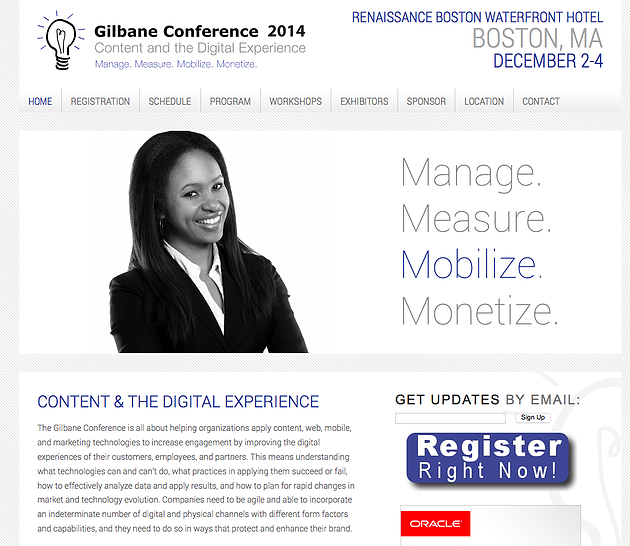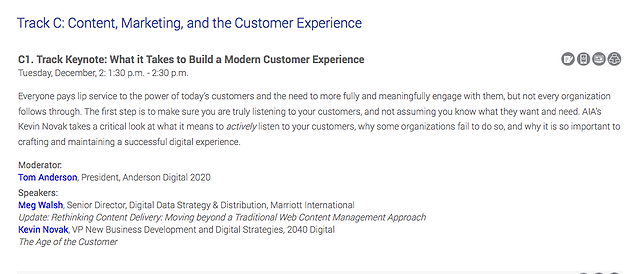Why You Should Build a Modern Customer Experience
Tom Anderson from Anderson Digital 2020 interviewed me ahead of speaking at the Gilbane Conference next month:
Tom: I’m pretty excited about the Gilbane Conference that’s running December 2nd to 4th in Boston. Am moderating two events, which is connecting me to some really bright panelists, including Kevin Novak, who is on the panel “What it Takes to Build the Modern Customer Experience.” Here’s a preview of his thinking:
Kevin, not to belabor the obvious, but what differentiates today’s customer experience to that of say, 2009
?
“The big monsters in the room are obviously digital and mobile and the resulting transition from in-person/phone customer interaction and purchase to digitally based self-service models and experiences. The world 5 years ago was predominately in person and digital was desktop/browser based and dare I say, blackberry dominant.
“Although Apple brought us the iPhone in 2007 and mobile made a huge jump, it really wasn’t until 2009/2010 when mobile interaction, experience and presentation became a necessity as mass adoption began.
“At the same junction, many new social interactive and connection apps, platforms and offerings began taking shape, creating demand and impact but also confounding users and businesses to determine where they should best apply their time and resources.
“Today, Instagram, Kick, Pinterest, and HotorNot dominate the teenage market while Facebook, Twitter and YouTube have hit their stride for the masses. Presence and location based opportunities are growing. Tomorrow may bring a whole new list of apps, communities and ways to connect and share.
“In this 5 year advance the world around us, impacting all markets, is a much different place. In this time the world has gone global, mobile, presence/location based and has become flat.”
You talk about demographic trends as well. Tell me more.
“The digital natives soon to be the majority of anyone’s customers, are very different than Gen X, Boomers and the like who have adopted technology, they have different demands and expectations. The content they consume, the demand for instant availability and connectivity of communication and content in a variety of formats, and the variety of social and other spaces they play add tension to traditional business.
“Digital Natives are accustomed to connecting online to communicate, share, buy and receive service. Most if not all Natives expect all businesses and organizations to be digitally available to meet their needs and ready to interact with them digital in the physical world via mobile, NFC, GPS or other methods.
“Their allegiance to brands and products is quite different than previous generations. They will move on to others/competitors when a business or organization isn’t or cannot interact with them and on their terms.
“The changing demographics have catalyzed many businesses and organizations to change their customer experience and support models. Those more progressive are recognizing the shift to an omni-channel model where feedback, communication and interaction occurs directly to the business or organization in person, on the phone and via their digital properties but also via indirect platforms and communities in the social space.
“The opportunities for engagement are also changing how a business or organization thinks about their customer journey. Mapping the customer journey today is no longer dealing in straight lines or nice shapes or nice simple charts. Today’s journeys are spider webs of potential and real interaction, potential and real engagement and multi level multi channel experiences.
“The ever blooming technology options have created opportunities for businesses and organizations to adopt digital customer service offerings, abilities to gain insight and feedback that can be ingested in real time, measurement of brand/product voice and conversation via social platforms, direct communication, delivery and sharing opportunities via mobile and near field communications/location-based, and mechanisms to collect and curate big data around their business, products and customers to gain critical and impactful insights that inform strategy and direction.
“Today’s world is much more complex and dynamic than it was 5 years ago. Customer experience and the evolution of the experience field of practice will become a dominant force in setting organization and business direction and ultimately assume responsibility for financial goals.”
Thanks. Just one more question: Say you are the CEO of a billion dollar multinational. How to you know if your digital team is truly listening to your customers?
“We are in the voice of the customer age. Today’s digital world can build or sink an organization in the blink of an eye.
“You as a CEO, must be pro-active first in understanding how your organization is represented or is being talked about natively via your own digital channels but also in the greater digital world.
“Second, you need to be asking questions of your digital (if you have them) and customer service staff on how they are interacting with your customers and how they are listening to what your customers are saying about you, your products and your services.
“Thirdly, ask them what they are doing about what they are hearing.
“Lastly, ask them what mechanism, methodologies, or approaches are they using to measure and track the voice but also the results of actions taken.
“You as a CEO, must recognize that ultimately what your teams are hearing, what they are collecting, and the actions they are taking have an impact on your current and future financial performance. This isn’t new in many ways but the impact is much quicker and more immediate than it was before. Your decision-making, the availability data and what it tells you, and your competitor activities are all moving in a much faster world.
“It is important to understand the tools and strategies that customer support and digital teams are using to collect feedback, promote and capture interaction, measure and interpret input and translate the findings to actionable activities. This helps you as the CEO form and know what questions you should be asking to validate that the customer is being listened to and the teams are finding ways to integrate that feedback into their work and actions.
“Who do you look to for answers? Do you have a Chief Digital Officer or Chief Experience Officer? If not, you should get one.
“Do you know what data is being collected about your customers and how it is being used? If not you should.
“Do you know what Net Promoter is? What Word of Mouth Index is? What the Omni-Channel is? If not, you should.
“Lastly, do you know how you and your company listen? Really actively listen to what is being said?
“Perhaps you are already drawing conclusions or the next question before someone is finished speaking. You may want to reconsider how you listen and move you and your organization to more active listening approaches so that you benefit from what is really being said.
“You may know what you want to hear, your people may know what to tell you, but you as the CEO need to ensure the voice of the customer is shining through and being considered in the decision making and actions of the organization without filters.”






This Post Has 0 Comments